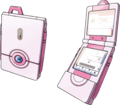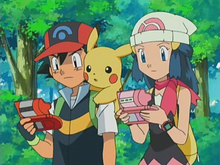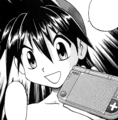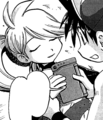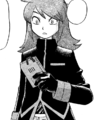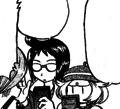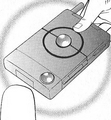Pokédex
- Zukan redirects here. For Japanese figures named after the Pokédex, see Pokémon Zukan figures. For the guidebook localized as Pokémon Zukan in English media, see Pocket Monsters Encyclopedia.
- DEX redirects here. For the Pokémon Trading Card Game expansion abbreviated as DEX, see Dark Explorers (TCG).
The Pokédex (Japanese: ポケモン図鑑 illustrated Pokémon encyclopedia) is an invaluable tool to Trainers in the Pokémon world. It gives information about all Pokémon in the world that are contained in its database, although it differs in how it acquires and presents information over the different media. However, they are also only given to a few Trainers at a time, generally to the ones that are felt to have exceptional potential and skill. Regional Pokédexes give information about Pokémon native to a particular region, while the National Pokédex records information about all known Pokémon. While the concept of a Pokédex has existed for a long period, the digital version of it is a more recent invention created by Professor Oak.
Pokédex entries typically describe a Pokémon in only two or three sentences. They may give background information on the habitat or activities of a Pokémon in the wild or other information on the Pokémon's history or anatomy. Pokédex entries also include height, weight, cry, footprint (prior to Generation VI), location, other forms, and a picture of the Pokémon.
In the core series
The modern Pokédex is a handheld electronic encyclopedia device; one which is capable of recording and retaining information of the various Pokémon of the world. In order to accomplish Professor Oak's goal of a complete Pokémon database, the Pokédex is designed to find and record data on each Pokémon the Trainer meets. Pokémon are added to the Pokédex simply by encountering them in battle or, sometimes, by seeing a picture of the Pokémon. However, detailed entries are not recorded until the player obtains the Pokémon, such as through catching, evolving, breeding, gifts, or trades.
Models
The Pokédex models with known names are: HANDY505RBY, HANDY808GSC, HANDY909FRLG, and HANDY910DPPt.
In Pokémon HeartGold and SoulSilver, while artwork shows a pink Pokédex for females, the in-game interface does not reflect this.
In Pokémon Black, White, Black 2, and White 2, extra Pokédex skins could be downloaded through the Pokémon Global Link. There was a total of seven downloadable skins, but only a maximum of five skins have been made available for each gender of the player:
| Male player | Female player |
|---|---|
| Unova Starters (red) | Unova Starters (pink) |
| Kanto Starters (red) | Kanto Starters (pink) |
| Hugh StyleB2W2 | |
| Bianca Style | |
| Cheren Style | |
In Pokémon X and Y, the Pokédex is card-shaped and has a holographic center that is visible when the two ends are separated.
In Pokémon Sun, Moon, Ultra Sun, and Ultra Moon, the Pokédex consists of a device specially-designed to be inhabited by a Rotom, an innovation that gives the Pokédex its own personality and is intended as a new way for humans and Pokémon to communicate. The Rotom Pokédex is a rare model even in the Alola region where it was created.
In Pokémon Sword and Shield, the Pokédex is an application Sonia installs in the player's Rotom Phone after she is met for the first time. Additionally, when the player first arrives in the Isle of Armor or Crown Tundra, a doctor will install the regional Pokédex for that area on the player's Rotom Phone.
In Pokémon Brilliant Diamond and Shining Pearl, the Pokédex visually and functionally works how it did in Diamond and Pearl, however the interface was changed for optimization on a TV rather than the Nintendo DS's dual-screen layout.
In Pokémon Legends: Arceus, due to taking place in the past, the Hisui Pokédex appears to be the least advanced out of all current Pokédex models, simply being a book rather than an electronic device.
The Paldea Regional Pokédex takes on the appearance of a digital bookshelf, with the Pokémon's entries being books. Seeing the Pokémon creates a blank covered book and registering them as captured gives a photographic cover to the book. Pokémon entries adjacent to seen Pokémon are shown as blank spaces, but can be selected to reveal a silhouette and the location of the Pokémon. This particular iteration of the Pokédex was invented by Jacq.
List of Pokémon
The list design has varied between generations:
- From Generation I to Generation III, and from Pokémon: Let's Go, Pikachu! and Let's Go, Eevee! onwards, the Pokédex list is displayed as a single page.
- In Pokémon Diamond, Pearl, and Platinum, the Pokédex list is displayed in the top screen.
- In Pokémon HeartGold, SoulSilver, X, and Y, the top screen displays the Pokémon entry and bottom screen displays the Pokédex list.
- In Pokémon Black, White, Black 2, and White 2, the list is displayed on the right side of both screens with the selected Pokémon's sprite occupying the left side of the bottom screen.
- In Pokémon Omega Ruby, Alpha Sapphire, Sun, Moon, Ultra Sun, and Ultra Moon, the Pokédex list is displayed in the bottom screen.
In several core series games, simply pressing A on a Pokémon listed in the Pokédex opens its Pokédex entry. In Generation I, this is known as the "Data" option. In some games, this is known as "Details" or "See Details".
In Generation I's Pokédex, the entries are simple and each individual section can be accessed directly from the listing. From Generation II onwards, selecting a Pokémon displays the entry in a new screen from which the other sections can be selected.
The number of caught and seen Pokémon is displayed together with the list of Pokémon. From Pokémon Sun and Moon onwards, it also displays the total percentage of Pokédex completion. The player can also scan QR codes to add Pokémon they haven't encountered yet to the Pokédex, allowing them to check the Pokémon's location.
In Pokémon Gold, Silver, and Crystal, there is an Unown Mode available. In Pokémon HeartGold and SoulSilver, the Unown Report is a Key Item rather than part of the Pokédex. In Pokémon Legends: Arceus, the player has the ability to open an Unown Pokédex by pressing the Y button when the Pokédex's cover is shown.
Ordering systems
In each game, the Pokémon are ordered by default in the respective regional Pokédex order. From Generation II to Generation VI, the National Pokédex (which includes all the available Pokémon to date) can be obtained by several means, depending on the game.
From Generation II onwards, there is the option to list Pokémon in alphabetical order.
From Generation III onwards, except in Pokémon FireRed and LeafGreen there is the option to list Pokémon by height (tallest or smallest), as well as weight (heaviest or lightest)
In Pokémon X and Y, the Pokédex is separated into three categories: Central Kalos (the first one unlocked), Coastal Kalos (unlocked by Sina and Dexio upon entering Route 8), and Mountain Kalos (unlocked by Sina and Dexio in the gate between Coumarine City and Route 13, after beating Ramos), and each category has a different icon in the Pokédex menu. The Coastal Pokédex is represented by a blue stripe on the left side of a pentagon, the Central Pokédex is represented by a white stripe down the middle of a pentagon, and the Mountain Pokédex is represented by a red stripe on the right side of a pentagon. The symbol for the National Pokédex is a Poké Ball.
In Pokémon Sun, Moon, Ultra Sun, and Ultra Moon, the Alola Pokédex is divided into several categories, with a section for each of the four main islands of the region. In those games, the National Pokédex has are color codes used to represent Pokémon introduced in each generation: red for Generation I, yellow for Generation II, green for Generation III, blue for Generation IV, pink for Generation V, and silver for Generation VI.
No Pokémon is found in multiple sections of the Kalos Pokédex, but some are found in multiple sections of the Alola Pokédex.
In Pokémon Legends: Arceus, Hisui's features different sections of Pokémon organization by separating them by area or within the entire Hisui region. In this game, a majority of the Pokémon in this Pokédex are shared with the Pokédex in Platinum, as both games take place in the Sinnoh Region.
Search and additional lists
In the Generation I core series games, there was no search function, although it was possible to search Pokémon in the Pokédex from the Pokémon Stadium series.
The search function available in all core series from Generation II onwards, except in Pokémon FireRed and LeafGreen there are separate lists of Pokémon instead of a search function. From Generation II to V, it was only possible to search for Pokémon that have been caught; in Generation VI, the ability to search for Pokémon that are not caught was added.
From Generation II onwards, except in FireRed and LeafGreen, it is possible to search Pokémon by type. In FireRed and LeafGreen, there are lists of Pokémon by type.
In Pokémon Ruby, Sapphire, and Emerald, as well as Generations V-VII, it is possible to search Pokémon by color. In FireRed and LeafGreen, there are lists of Pokémon by color.
In Pokémon Ruby, Sapphire, and Emerald, and from Generation IV onwards, it is possible to search Pokémon by the first letter of the name.
In Pokémon FireRed and LeafGreen only, there are lists of Pokémon according to their habitat.
From Generation IV to Pokémon Ultra Sun and Ultra Moon, it is possible to search Pokémon by shape.
In Pokémon HeartGold and SoulSilver, it is possible to search Pokémon from either Kanto or Johto.
In Pokémon Black 2 and White 2, after defeating Cheren for the first time, Bianca will upgrade the player's Pokédex with the Habitat List, showing which Pokémon the player has already seen in the selected location, either normally, by finding in the water or via fishing rod (the latter two available later). If all Pokémon available in that place that are available via one of these three ways are seen (such as Purrloin and Patrat for tall grass on Route 19), the reference to the location in such way is marked with a Poké Ball-like stamp; after catching all Pokémon that are found via one of these three ways in current place, it gets marked with a colored Poké Ball-like stamp. It is not possible to use the Search Function in the Habitat List mode of the Pokédex.
In Pokémon X and Y, only the currently set form of a Pokémon will be considered by the Pokédex when sorting and searching. All other forms will be ignored, and the form setting will not change to make the Pokémon match the search criteria. If the form is changed in the entry and the Pokémon either no longer matches the search criteria or belongs in a different place in the list, its entry will vanish or move according to its new form.
In Pokémon Omega Ruby and Alpha Sapphire, there is also an option to search for Pokémon whose Mega Evolution form or Shiny appearance have been registered. From this game onwards, all forms of a Pokémon registered will be taken in account when sorting and searching, even if they aren't the currently set form.
In Pokémon Sun, Moon, Ultra Sun, and Ultra Moon, it is possible to search for Pokémon whose Alolan has been seen.
In Pokémon Sun and Moon, the search/sorting function is only available in the Alola Pokédex proper, not in the Melemele, Akala, Ula'ula, and Poni Island Pokédexes.
Entries
The main feature of any Pokédex are the entries on each individual Pokémon, which provide details that would otherwise be unexplored in the games. If a Pokémon is caught, its full Pokédex entry becomes available. A Pokémon that was seen but not caught has a partial entry.
From Generation VII onwards, some Pokémon forms have separate Pokédex entries, each form with its own text description, type, category, height, and weight. In some cases, this includes separate entries for regional forms, Mega Evolutions, Gigantamax forms, Pikachu in a cap, and so on.
The table below contains the information available in the Pokédex.
| Game | RBY | GSC | RSE | FRLG | DPPt | HGSS | BW | B2W2 | XY | ORAS | SM | USUM | PE | SwSh | BDSP | LA | SV |
|---|---|---|---|---|---|---|---|---|---|---|---|---|---|---|---|---|---|
| (available for a seen Pokémon) Pokédex number Image (sprite or render) Category Cry Area map |
✔ | ||||||||||||||||
| Species name Description Height value Weight value |
✔ | ||||||||||||||||
| Footprint | ✘ | ✔ | ✘ | ||||||||||||||
| Type | ✘ | ✔ | |||||||||||||||
| Height comparison | ✘ | ✔ | ✘ | ||||||||||||||
| (available for a seen Pokémon) Cry's visible soundwaves |
✘ | ✔ | ✘ | ✔ | ✘ | ✔ | |||||||||||
| (available for a seen Pokémon) List of forms Gender differences |
✘ | ✔ | |||||||||||||||
| Foreign entries | ✘ | ✔ | |||||||||||||||
| Weight comparison | ✘ | ✔ | ✘ | ||||||||||||||
| Forms with separate entries | ✘ | ✔ | |||||||||||||||
Although it is possible to search Pokémon by color in Generations III–VII, a Pokémon's color is not visible in the Pokédex entries.
In Pokémon Legends: Arceus, unlike most Pokédexes the Pokémon’s entry is not immediately added upon being captured with it only completed by doing research tasks. Additionally many of the entries are written in first person by Professor Laventon. The cover of the book starts out brand new at the beginning of the game but slowly becomes more worn as the game progresses.
Description
A short text description is available for each Pokémon in the Pokédex.
In Generation I, the Pokédex text entry is split into two pages; the player can press A to go to the next page. In Generation II, the Japanese games do not have multi-page Pokédex entries; international versions have a "Page" button for long Pokédex entries. In Pokémon Ruby and Sapphire, there is a Page button to switch between pages of multi-page Pokédex entries.
From Pokémon FireRed and LeafGreen onwards, the description is displayed on a single page for each Pokémon.
In Pokémon Diamond and Pearl, foreign Pokédex entries are available for 14 Pokémon species after the player meets Meister. In Pokémon Platinum, this function was expanded to all Pokémon, although it still requires Meister to update the Pokédex. From Pokémon HeartGold and SoulSilver onwards, foreign entries are available for all Pokémon from the start of the game.
From Pokémon Sun and Moon onwards, but excluding Pokémon Brilliant Diamond and Shining Pearl, some Pokémon with alternate forms have separate Pokédex entries for their different forms, provided that those alternate forms are available in the game's regional Pokédex. This includes, but is not limited to, regional forms, Mega Evolutions in Generation VII, and Gigantamax forms in Pokémon Sword and Shield.
Some games share the same Pokédex entries about certain Pokémon (in particular, some remakes reuse most or all entries from the remade games):
- The Japanese games Pokémon Red and Green share the same Pokédex entries, which were originally left untranslated in English until they were reused in later games.
- The Japanese Pokémon Blue introduced new Pokédex entries, which were translated into English in Pokémon Red and Blue.
- In Pokémon Yellow, as well as in Pokémon Gold, Silver, and Crystal, no Pokédex entries were reused from previous games. Each Pokémon species has a different entry in those games.
- In Pokémon Ruby and Sapphire, there are no Pokédex entries reused from previous games. The Pokémon in the Hoenn Pokédex have separate entries in each game. All other Pokémon share the same entry in both games.
- In Pokémon FireRed and LeafGreen, the Generation I and II Pokémon had their entries reused from previous games, and Generation III Pokémon have new entries.
- The Generation I Pokémon had their FireRed entries reused from Pokémon Red and Green (being translated into English for the first time), and their LeafGreen entries reused from Pokémon Red and Blue (originally from Japanese Pokémon Blue).
- The Generation II Pokémon had their FireRed and LeafGreen entries reused from Pokémon Silver and Gold, respectively.
- Deoxys is the only Generation III Pokémon whose FireRed and LeafGreen entries are different from each other; all other Pokémon from this generation share the same entry in both games.
- In Pokémon Emerald, the Pokémon in the Hoenn Pokédex have a new entry. All other Pokémon reuse the entry shared by Ruby and Sapphire.
- None of the Pokédex entries from Emerald have been reused in any other game thus far, possibly due to their length.
- In Pokémon Diamond and Pearl, there are no English Pokédex entries reused from previous games.
- In Japanese, Parasect has the only reused Pokédex entry, having the same text in Pearl that was previously used LeafGreen and Blue. However, Parasect's English Pokédex entry in Pearl was translated with different wording than the one used in previous games.
- In Pokémon Diamond and Pearl, the Pokémon available in the Sinnoh Pokédex, as well as Darkrai, Shaymin, and Arceus, have different Pokédex entries in each game. All other Pokémon share a single entry in both games, except Parasect as mentioned above.
- In Pokémon Platinum, all Generation IV Pokémon and all Pokémon available in the Sinnoh Pokédex (which was expanded with more Pokémon than in previous games) have a new Pokédex entry.
- Parasect reuses the Pokédex entry from Diamond.
- All other Pokémon reuse the entry shared by Diamond and Pearl.
- In Pokémon HeartGold and SoulSilver, all Pokémon that appeared in Gold and Silver have their Pokédex entries reused in HeartGold and SoulSilver, respectively. Pokémon introduced in Generation III or Generation IV have new Pokédex entries.
- The five Pokémon introduced in Generation IV that appear in the Johto Pokédex (Ambipom, Tangrowth, Yanmega, Mamoswine, and Lickilicky) have new entries that are different between the two games, while all other Pokémon introduced in Generation III or Generation IV share a single entry in both games.
- In Pokémon Black and White, all Generation V Pokémon have new Pokédex entries that are different between those two games.
- All the Pokémon from earlier generations reuse their entries from Pokémon Platinum (effectively reusing entries introduced in Diamond and Pearl for most Pokémon excluded from Platinum's Sinnoh Pokédex).
- In Pokémon Black 2 and White 2, all Pokémon in the Unova Pokédex have new entries. All other Pokémon have entries reused from Pokémon Platinum, the same as in Black and White, but some have minor wording changes.
- In Pokémon X and Y, all Generation VI Pokémon have new Pokédex entries that are different between those two games.
- The Pokémon from earlier generations have entries reused from several games.
- In Pokémon Omega Ruby and Alpha Sapphire, only Kyogre, Groudon, Rayquaza, and Hoopa have new entries, which are different between those two games.
- All other Pokémon from Generations I-III reuse their entries from Pokémon Ruby and Sapphire, respectively.
- All other Pokémon from Generations IV-VI reuse their entries from Pokémon X and Y, respectively.
- In Pokémon Sun, Moon, Ultra Sun, and Ultra Moon, the only Pokémon with entries are those available in the Alola Pokédex (either the first versionSM or the expanded second versionUSUM).
- No Pokédex entry in those games was reused from previous games or repeated between multiple Alola games.
- In Pokémon: Let's Go, Pikachu! and Let's Go, Eevee!, only the Pokémon in the Kanto Pokédex have entries.
- Most Pokémon have their entries reused from Pokémon Yellow, except Pikachu, Eevee, Meltan, and Melmetal, the available Mega Evolutions, and the Alolan Forms have new entries.
- Arcanine's Pokédex entry was reused from Pokémon Yellow, except now saying that this Pokémon is legendary in the East (instead of legendary in China).
- In Pokémon Sword and Shield, Pokémon in the Galar Pokédex, Isle of Armor Pokédex, or Crown Tundra Pokédex have entries. Pokémon and alternate forms in the Galar Pokédex or that are compatible with Sword and Shield that are not in any Galar Pokédex have new Pokédex entries that are different between Sword and Shield, if they were introduced in Generation IV or later, as do a few other Pokémon introduced prior to Generation IV. Pokémon exclusive to the Isle of Armor or Crown Tundra have new Pokédex entries that are different between Sword and Shield, regardless of when those Pokémon were introduced, with the exception of the Bulbasaur and Squirtle evolutionary families. The exceptions are Legendary Pokémon, which have new Pokédex entries that are different between Sword and Shield if they are not in any Galar Pokédex. These Pokédex entries are only viewable in Pokémon HOME.
- Pokémon with reused Pokédex entries have their entries reused from several games.
- In Pokémon Brilliant Diamond and Shining Pearl, every Pokédex entry is reused from either Diamond or Pearl, respectively.
- In Pokémon Legends: Arceus, no Pokédex entries are directly reused from previous games, as many of the entries are written in first person by Professor Laventon.
- In Pokémon Scarlet and Violet, Pokémon in the Paldea Pokédex have entries. Pokémon introduced in Generation VI or later have new Pokédex entries, as do some Pokémon introduced before Generation VI.
Forms
From Generation IV onwards, the Forms page allows the player to see a list of forms and gender differences, as long as the player has seen them before. In Pokémon HeartGold and SoulSilver, Forms added a Compare option to see different forms side by side instead of having to scroll between them.
From Generation IV to Generation VI, males and females of all Pokémon with differing gender are shown separately under in the Forms section even if there is no visible gender difference.
In Generation V, the Forms page is added by Cedric Juniper when the player visits Mistralton City.
From Generation V onwards, the Forms page displays Shiny Pokémon as well, and the last sprite selected will become the one displayed in the main entry.
From Generation VII onwards, a Pokémon's gender is only shown separately under the Forms section if there is a visible gender difference. Starting this generation, several Pokémon have separate Pokédex entries for different forms, including event-exclusive forms, regional forms and Mega Evolutions. Each form's entry has its own text blurb, and may also have a different category, type, height, weight, color, and shape.
In Generation IX, however, the PokéDex doesn't have a Forms page, and players can view the forms of the Pokémon they caught last.
Cry
In Generation I, the Pokédex list has an option to play the Pokémon's cry (without opening a new screen). From Generation II onwards, the Pokémon's cry is available once the player enters the Pokémon entry.
In most games from Generation III onwards, the Pokémon's cry option (available from the Pokémon entry page) now brings the player to a separate page, which displays the sound wave as it is played. However, there is no Cry page in Pokémon FireRed, LeafGreen, HeartGold, or SoulSilver.
In Pokémon Diamond, Pearl, and Platinum, Cry has a bar display in addition to the wave display, and the ability to modify the cry via Chorus/Pan, Reverb/Filter and Loop.
In Pokémon Brilliant Diamond and Shining Pearl, the player can change the filters put on cries by using the gyro sensors on their controllers, as opposed to a touch screen.
Area
In Generation I, the "Area" option displays the map, along with flashing indicators at each location where the selected Pokémon can be found; in cases where the Pokémon is not available in the wild, is only available once, or can only be found by fishing or in the Unknown Dungeon, the message "Area Unknown" will be displayed over the center of the map instead.
In Generation II, entries that would normally display "Area Unknown" on the map simply display an unmarked map.
In Generation III, the Area section was changed to highlight locations instead of just marking them and can now display the locations of Pokémon obtainable by fishing.
In Pokémon Diamond, Pearl, and Platinum, Area now changes its highlight color depending on whether a Pokémon is found normally or exclusively using Honey, and the player can view the differences between morning, day and night, with the default being the current time.
In Pokémon HeartGold and SoulSilver, Area no longer defaults to the current time or differentiated for Honey due to it no longer being a mechanic,
In Pokémon Black, White, Black 2, and White 2, instead of showing the time of day that a Pokémon can be caught, the Pokédex shows the seasons in which it can be found. Areas in which the Pokémon can be found flash red, and touching an area will show the methods by which it can be caught (walking in tall grass, surfing, or fishing).
Origin
In Pokémon X and Y, if the player obtains a Pokémon originated from these games, the symbol in the Pokédex indicating it has been caught is a combination of the three Kalos Pokédex symbols: a pentagon with vertical blue, white, and red stripes. This resembles the flag of France, the region on which Kalos is based. If a Pokémon is transferred from another game, the symbol will instead be a Poké Ball. The latter symbol can be updated to the former symbol if the player obtains a Pokémon of that species originating from Generation VI. If all Pokémon are obtained from Generation VI games, the Pokédex will be marked with a crown on the selection screen.
Footprint
From Generation II to Generation V, and in Pokémon Brilliant Diamond and Shining Pearl, a Pokémon's entry displays its footprint.
In Brilliant Diamond and Shining Pearl, pressing the + button on a Pokémon's entry will change their footprint from a single footprint to all footprints if available, showing whether a Pokémon is bipedal or quadrupedal.
Height and weight
The Pokémon's height and weight is displayed in all generations.
In Generation III, a Size section was added, which displays silhouettes of the Pokémon and the player character side by side.
In Generation IV, weight was added to the Size section, which puts the Pokémon and the player character on either side of a balance scale. In Pokémon HeartGold and SoulSilver, Size now uses both screens to display both Height and Weight at the same time
Map and recommendations
In Pokémon Sun, Moon, Ultra Sun, and Ultra Moon, in addition to a standard Pokédex function, the Rotom Pokédex includes a detailed map that can point out nearby locations of interest, and remind the player of the next objective based on recent conversations with NPCs.
In Pokémon Sword and Shield, once per day, the Pokédex will give the player a recommended place to look for Pokémon to complete their Pokédex; these recommendations globally increase the encounter rates of the recommended species, excluding wanderer and curry encounters.[1] When in an area where the recommended species can be encountered, the bonus has 50% chance to activate and attempt to spawn a recommended species, with a 25% chance for each of the 4 recommended species slots being selected. This fails if it lands on a blank recommendation slot, or a species that doesn't spawn in the current encounter pool, in which case it defaults to the normal encounter pool.[2] This bonus only affects the first form of a recommended species, determined by the index number of the form.[3] As an example, Sinistea being recommended in the Old Cemetery would also boost the encounter rate of Sinistea in Glimwood Tangle, but only for Phony Form Sinistea, not Antique Form.
Printing entries
In Pokémon Yellow, Gold, Silver, and Pokémon Crystal, it is possible to print entries of caught Pokémon using the Game Boy Printer.
Evaluation
There are various mechanisms to evaluate the number of Pokémon in the Pokédex. These mechanisms will display a quote relating to the number of Pokémon seen or caught, often including a hint to the player of how to progress.
In all games in which Professor Oak appears, he will evaluate the player's Pokédex according to the number of Pokémon they have caught. In games which feature the National Pokédex, Oak's evaluation takes this into account, but in a different way according to the game:
- In Pokémon FireRed and LeafGreen, Oak gives specific quotes according to the number of Pokémon caught in the regional Pokédex, and a general quote according to whether they have completed the National Pokédex or not
- In Pokémon Diamond, Pearl, and Platinum, Oak will only comment on the National Pokédex, according to the number of Pokémon caught
- In Pokémon HeartGold and SoulSilver, Oak will comment on both the regional and National Pokédexes, according to the number of Pokémon caught
In the Hoenn-based games, Professor Birch will evaluate the player's Pokédex:
- In Pokémon Ruby and Sapphire, Birch comments on the regional Pokédex, according to the number of Pokémon caught, but only after Wally catches a Ralts. He will also give the number of Pokémon caught in the National dex, after it is obtained
- In Pokémon Emerald, it works the same as Pokémon Ruby and Sapphire, except that Birch will start to evaluate after the player gets the PokéNav
- In Pokémon Omega Ruby and Alpha Sapphire, Birch will comment on the regional Pokédex according to the number of Pokémon seen, and the national Pokédex according to the number caught
In Pokémon Diamond, Pearl, and Platinum, as well as Oak evaluating the National dex as noted above, Professor Rowan will also evaluate the regional dex according to the number seen.
In Pokémon Black, White, Black 2, and White 2, Professor Juniper will evaluate the regional Pokédex according to both seen and caught Pokémon, while Cedric Juniper will evaluate the National Pokédex.
In Pokémon X and Y, Professor Sycamore will evaluate all three regional Pokédexes according to seen Pokémon, and the National Pokédex according to caught Pokémon.
In Pokémon Sun, Moon, Ultra Sun, and Ultra Moon, the Rotom Pokédex itself will evaluate according to the number of Pokémon seen in each of the four islands as well as in Alola as a whole.
In Pokémon Sword and Shield, the Rotom Phone itself will evaluate according to the number of Pokémon seen in the main area of Galar, the Isle of Armor, and the Crown Tundra.
Completion
- See also: Diploma
Completing the Pokédex is a common goal of Trainers and carries with it much esteem due to its difficulty, which has gradually escalated due to the fact that around 100 new Pokémon are introduced with each new generation. However, this is mitigated to a degree by new features added to the games, such as Wi-Fi and the Global Trade System in Generation IV, and a less restrictive trading system (between PC boxes instead of only active teams) in Generation V. The exclusion of event Pokémon as a requirement for completing the Pokédex also makes it possible for people with no access to event distributions to complete the Pokédex.
The in-game rewards are usually a congratulations from the director's avatar and a diploma, usually one for completing the regional Pokédex and one for the National Pokédex. In Emerald, the player could choose from one of the Johto starter Pokémon for completing the Hoenn Dex. The completion of the Pokédex also usually allows the player to upgrade their Trainer Card. Also, in Pokémon Black and White, the diploma will appear on the shelf in the player's bedroom.
In Generations I to III, the completion of the regional Pokédex is tracked by how many Pokémon the player has caught. However, in Pokémon Diamond and Pearl and Platinum, the regional Pokédex is tracked simply by how many Pokémon the player has seen. In Pokémon HeartGold and SoulSilver, though, it again registers only Pokémon that have been caught. In Generation V, though Professor Juniper originally evaluates the player's regional Pokédex based on the Pokémon the player has seen, they may still only receive a diploma after having caught all regional Pokémon. Completion of the National Pokédex is always based only on the number of Pokémon caught.
In Pokémon Black and White 2, the system is revised to give the player more in-game recognition of their achievements. Once all the Pokémon in the Unova Pokédex have been seen, Professor Juniper presents the player a Permit, allowing access to the Nature Preserve. Once the player has caught all of the Pokémon in the Unova Pokédex, Professor Juniper will give the player an Oval Charm which increases the chances of finding Pokémon Eggs at the Pokémon Day Care. When the player completes the National Pokédex, Professor Juniper gives the player a Shiny Charm, which increases the chances of encountering and hatching Shiny Pokémon.
In Pokémon X and Y, Professor Sycamore will reward the player with an Oval Charm upon seeing all Pokémon in the Kalos Pokédex, except for Articuno, Zapdos, Moltres, and Mewtwo. Upon completing the National Pokédex, the player will receive a Shiny Charm from Sycamore.
In Pokémon Omega Ruby and Alpha Sapphire, Professor Birch will reward the player with an Oval Charm upon seeing all Pokémon in the Hoenn Pokédex, except for Jirachi. Should the player complete the National Pokédex, Birch will also reward the player with a Shiny Charm. Also in Omega Ruby and Alpha Sapphire, the diplomas given by the director can be displayed in the player's Secret Base and can be viewed in the same way when obtaining it from the director. Other players visiting the secret base cannot see the full image on the diplomas, but instead will view it as an "impressive certificate".
Acquisition
Pokédex
|
Upgrades
- For the National Pokédex upgrade locations, see National Pokédex
|
Gallery
Interface

|
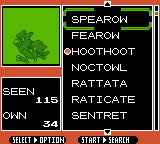
|
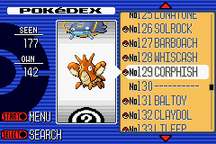
|
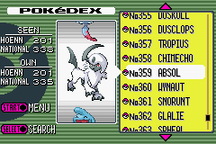
|
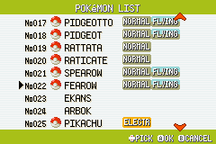
| |
|---|---|---|---|---|---|
| RBY | GSC | RS | E | FRLG | |

|
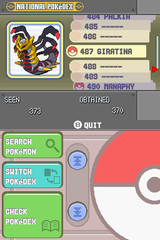
|
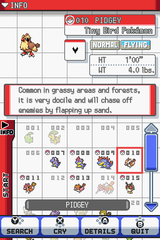
|
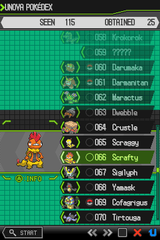
|
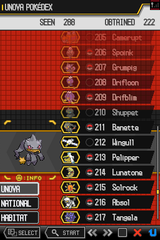
| |
| DP | Pt | HGSS | BW | B2W2 | |

|
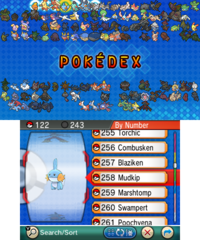
|

|
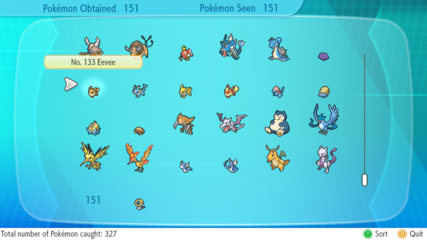
| ||
| XY | ORAS | SMUSUM | PE | ||
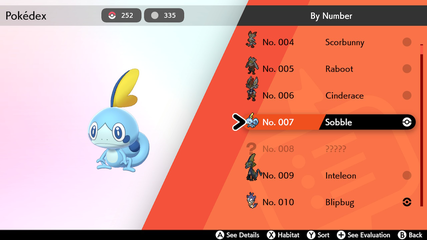
|
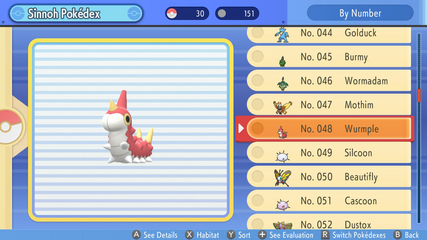
|
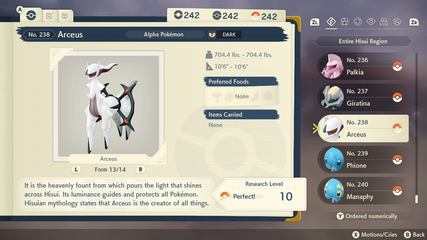
| |||
| SwSh | BDSP | LA | |||
Search

|
This section is incomplete. Please feel free to edit this section to add missing information and complete it. Reason: Add images of the Pokédex search function |
Entry

|

|
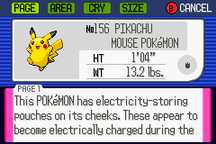
|
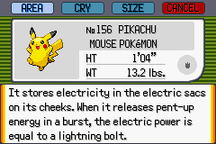
|
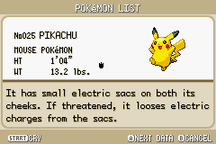
| |
|---|---|---|---|---|---|
| RBY | GSC | RS | E | FRLG | |
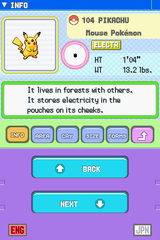
|

|
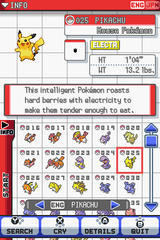
|
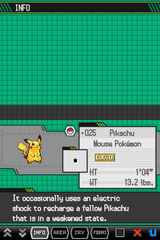
|
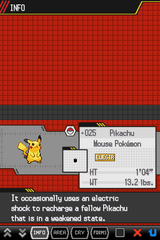
| |
| DP | Pt | HGSS | BW | B2W2 | |
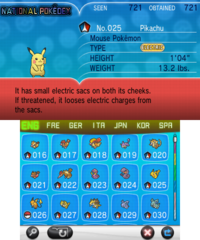
|

|

|

| ||
| XY | ORAS | SMUSUM | PE | ||
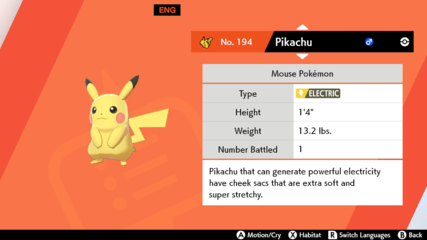
|

|

| |||
| SwSh | BDSP | LA | |||
| File:Pokedex Entry SV.png | |||||
| SV | |||||
Sprites
| Overworld sprite from Generation I |
Overworld sprite from FireRed and LeafGreen |
Male player obtain sprite from Generation V |
Female player obtain sprite from Generation V |
Obtain sprite from Sun, Moon, Ultra Sun, and Ultra Moon |
Sprite from Legends: Arceus |
Artwork
The Kanto Pokédex in Pokémon Red and Green
The Kanto Pokédex in Generation I
The Johto Pokédex in Generation II
The Hoenn Pokédex in Generation III
The Sinnoh Pokédex in Pokémon Diamond and Pearl
The Sinnoh Pokédex in Pokémon Platinum
The male Johto Pokédex in Generation IV
The male and female Unova Pokédexes in Generation V
The Kalos Pokédex in Generation VI
The Alola Rotom Pokédex in Generation VII
- LGPE Pokedex.png
The Kanto Pokédex in Generation VII
The Galar Rotom Phone in Generation VIII
The Hisui Pokédex in Pokémon Legends: Arceus
The Paldea Rotom Phone in Generation IX
In the side games
Pokémon Stadium series
- Main article: Pokédex (Stadium)
The Pokédex is available in all games of the Pokémon Stadium series. It includes a 3D visualization of the Pokédex from core series games connected via Transfer Pak. The Pokédex is seen as a dual-screen computer at the Pokémon Lab, with the exception of the Japanese Pokémon Stadium.

|

|
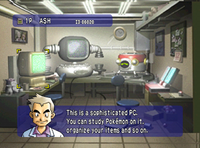
|

|

|

|
|---|---|---|---|---|---|
| Stadium (Japanese) | Stadium (Japanese) | Stadium (English) | Stadium (English) | Stadium 2 | Stadium 2 |
Additionally, only in the English version of Pokémon Stadium, the rental Pokémon are listed in the Kanto Pokédex order. This is not the case with the Japanese version, which lacks rental Pokémon and Pokémon Stadium 2, which displays rental Pokémon in alphabetical order.
Pokémon Bank
As part of its version 1.3 update to be compatible with Generation VII, a National Pokédex feature was also added to Pokémon Bank. Bank's National Pokédex is able to display Pokédex entries from any Generation VI game as well as Pokémon Sun and Moon. The Pokédex is updated based on the data of any game that is used to connect to Pokémon Bank.
Pokémon Bank's National Pokédex has an extensive search feature, including the ability to filter Pokémon by the games they are naturally available in (not counting the possibility of obtaining a Pokémon by breeding or evolving), as well as the ability to show the Kanto, Johto, "Good Old Hoenn", Sinnoh, Unova, Kalos (divided into Central, Coastal, and Mountain), Hoenn, and Alola Pokédex orders. While the application has since been updated to be compatible with Pokémon Ultra Sun and Ultra Moon, and later, Pokémon HOME, the Pokédex was never updated to include the Pokémon and Pokédex from the former two games.
Gallery
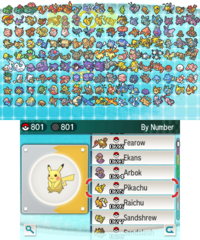
|

|
|---|---|
| Interface | Entry |
Pokémon HOME
Pokémon HOME includes the full National Pokédex. It includes every Pokédex description since Pokémon X and Y, for each Pokémon. Completing the National Pokédex up to Eternatus (including Mythical Pokémon) makes the player eligible to receive an Original Color Magearna, made available for the first time in this alternate form.
When the player makes contact with a Pokémon Bank account for the first time, their National Pokédex on HOME will update and sync to include the entries on their National Pokédex from Bank up to Marshadow. Because Bank's National Pokédex was never updated to include Pokémon beyond that, this feature does not extend to Poipole, Naganadel, Stakataka, Blacephalon, and Zeraora.[citation needed]
Pokédex entries from Pokémon Legends: Arceus like in the game itself only appear when the player reaches research level 10 by completing a certain amount of research tasks.
Pokémon HOME also includes several Pokédex entries for Pokémon Sword and Shield that are not actually present in the games. This includes all Pokémon that were present in the 1.0 versions of the games, but did not actually appear in the game's Pokédex.
Gallery
Nintendo Switch

|
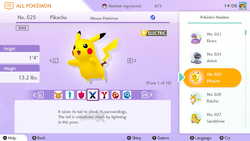
|
|---|---|
| Interface | Entry |
Mobile
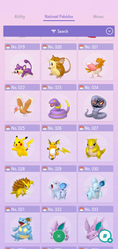
|
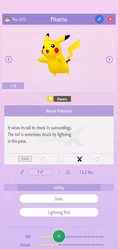
|
|---|---|
| Interface | Entry |
In the spin-off games
Pokémon Pinball series
- Main article: Pokédex (Pinball)
The Pokédex (also named "Poké Dex" with a space) is available from the main menu and displays a list of caught and seen Pokémon in the games Pokémon Pinball and Pokémon Pinball: Ruby & Sapphire.

|

|
|---|---|
| Pokédex (Pokémon Pinball) |
Pokédex (Pokémon Pinball: Ruby & Sapphire) |
Pokémon Tetris
In Pokémon Tetris, the Pokédex is available in the menu at the beginning of the game. It is a list of the Pokémon that were captured in the Tetris game, and how many of each species was captured. Each captured Pokémon has 3 images: the full detailed image that appears when a Pokémon species is captured for the first time in the Tetris game, the small black silhouette that appears when a Pokémon species is available for capture in the Tetris game but was never captured before, and the small drawing which appears when a previously captured Pokémon species is available to be captured again in the Tetris game. All Pokémon appear as unidentified "----------" lines by default, until they are captured.
There are 249 Pokémon in this game, listed in the National Pokédex order. Almost all Pokémon from Generation I and Generation II are available, except Mew and Celebi, which don't appear in the Pokédex. The slot #151 (Mew) is empty and the cursor can't point to it, while the slot #251 (Celebi) does not appear in the list since the Pokédex ends at the slot #250 (Ho-Oh). A Poké Ball symbol serves as the cursor, which the player can use to point at any listed Pokémon.
Gallery

|
|---|
| Pokédex |
Pokémon Ranger series
In Pokémon Ranger, Pokémon Ranger: Shadows of Almia, and Pokémon Ranger: Guardian Signs, there is no Pokédex, but they have regional Browsers that also list Pokémon and give them their own Browser number unique for each region. All Browsers can search for Pokémon by name, Poké Assist, Field Move, the Almia Browser can also search by Browser Number. The Fiore Browser can list Pokémon by Browser Number, letter, weight, and height.
Pokémon Trading Card Game series
In Pokémon Trading Card Game and Pokémon Trading Card Game 2: The Invasion of Team GR!, there is no Pokédex. However, when the "Check" command is used on any Pokémon card, the player may see information such as its Pokédex entry, category, height (known as "length"), weight, and National Pokédex number. This is based on the cards from the real-life Trading Card Game, which also include the same information.
The Pokédex card is available in both games. The Imakuni? card (found in both games) states that Imakuni? is a creature not listed in the Pokédex.
Additionally, the card album in the PC is a similar feature to the Pokédex. It lists cards in order and the quantity of cards owned by the player, not counting repeated cards. In both games, the cards are usually organized by their index number hidden in the internal data, which separates the Pokémon cards by type and then orders them by their National Pokédex number.
Gallery
Pokédex screen

|
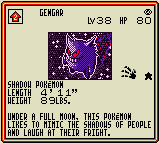
|
|---|---|
| Squirtle card (Pokédex screen) |
Gengar card (Pokédex screen) |
Pokédex card
| Pokédex card (GB1) | Pokédex card (GB2) |
|---|
In the anime

Main series
When a young Sam, who later turned out to be Professor Oak's younger self, was accidentally warped to a future of his own time, Ash explained to him how the Pokédex works, unknowingly giving him an idea. This is an example of a causal loop, meaning the idea for the Pokédex came out of nowhere.
In Pokémon - I Choose You!, Ash received his first Pokédex, apparently nicknamed "Dexter". Throughout the series, Ash uses it to either identify Pokémon he is not familiar with, check a Pokémon's moves, or identify Pokémon on request. Occasionally, though, Ash will scan Pokémon he has already seen, likely to either refresh his memory or out of curiosity.
In Pokémon Emergency, Officer Jenny informed Ash that the Pokédex can be used as an ID card. Since then, Ash has used his Pokédex to register for the various Pokémon Leagues he has participated in. As shown in Mounting a Coordinator Assault!, the Pokédex can also be used by Coordinators registering to obtain a Contest Pass for entering Pokémon Contests.
In Mystery at the Lighthouse, Brock informed Ash that a Pokémon Trainer can use their Pokédex to exchange their Pokémon.
In The Evolution Solution, it was mentioned that the Pokédex entries were written by Professor Westwood V of Seafoam Island. Unlike the games, entries in the anime are pre-programmed into the database and do not require catching to give full information. In this way, they act more as a true encyclopedia than a data-recording device. However, it should be noted that information relayed to the user may vary from time to time. This may happen even if the Pokédex remains unchanged in any way.
To look up information on a particular species, Trainers may simply point the Pokédex at an individual or manually enter it in. The Pokédex will then display a picture and read the entry out loud. The image displayed will be Ken Sugimori's official artwork. In The Legend of Thunder!, however, a stylized art of Raikou was shown when Jimmy looked it up.
In Pokémon the Series: Diamond and Pearl, it was revealed that it can identify the Pokémon's level and learned moves, even for wild Pokémon. Apparently, a picture or video recording of sufficient quality can also be scanned for information.
Attempting to identify an unknown Pokémon, usually one not native to the region the Pokédex was designed for, yields the message "no data". This message may also appear when scanning a Mythical or Legendary Pokémon.
In Kanto, Johto, and Unova, the Pokédex has a male voice; while in Hoenn, Sinnoh, and Kalos, it has a female voice. The upgraded Pokédex Ash and Serena received at the end of All Eyes on the Future! also has a male voice in the Japanese version. The gender of the voice may vary in some international dubs.
Like in the games, the Pokédex has gone through various designs. This includes its shape and way of opening, display, as well as the aforementioned voice. The Unova Pokédex redesign in the anime is significant, as it shows all the viewing angles from the Pokémon, with the exception of the back.
Trainers without the luxury of a Pokédex may have access to other means of finding information. Some use high-tech computers, like Giovanni in The Thief That Keeps On Thieving! or Shingo in Wired for Battle!. In several episodes, James used a deck of cards, which slightly resemble TCG cards. The deck of cards was replaced with a hologram laptop in Pokémon the Series: XY, and with a book in Pokémon the Series: Sun & Moon.
Pokédex entries
|
|
Gallery
Ash's original Pokédex
Ash's original Pokédex scanning a Bulbasaur
Ash's Johto Pokédex failing to scan Harrison's Blaziken
Ash's Hoenn Pokédex scanning Brawly's Makuhita
- PMC Pokedex Scan.png
The Pokémon Mystery Club's Pokédex scanning Brock's Lombre
Ash's second Kanto Pokédex scanning a Cleffa
Ash's second Kanto Pokédex failing to scan Gary's Electivire
May's Kanto Pokédex
May's Kanto Pokédex scanning a Celebi
Ash's Sinnoh Pokédex scanning a Snover
Dawn's Sinnoh Pokédex
- Mamie Lavender Pokedex.png
Mamie's Pokédex
Lyra's Pokédex scanning Dawn's Piplup
The Unova Pokédex
Ash's Unova Pokédex failing to scan Alexa's Gogoat
Bianca's Unova Pokédex
Bianca's Unova Pokédex scanning a Minccino
Ash scanning a Dedenne on his Kalos Pokédex
Ash scanning a Quilladin on his second Kalos Pokédex
Ash's second Kalos Pokédex failing to scan Squishy
The Rotom Pokédex in Alola
Rotom failing to scan Poipole
Ash's Rotom Phone
Goh's Rotom Phone
Goh's Rotom Phone scanning a Nickit
Goh's Rotom Phone failing to scan Zamazenta
Team Rocket's Rotom Phone
Team Rocket's Rotom Phone scanning a Drednaw
Shane Seeker's Rotom Phone
Chloe's Rotom Phone
Chloe's Rotom Phone scanning a Poliwag
Walker's Pokédex
Liko's Rotom Phone
Voice actors
| |||||||||||||||||||||||||||||||||||||||||||||||||||||
Pokémon Origins

The Kanto Pokédex appeared during the Pokémon Origins miniseries, where they served the same purpose as in the original Pokémon Red and Blue games. They recorded basic info of any Pokémon encountered, and detailed info of any Pokémon caught. Much like in the games, one was given to both Red and Blue by Professor Oak. By the end of the last episode of the miniseries, Red had managed to capture all 150 Generation I Pokémon, excluding only Mew. Blue's Pokédex was later crushed when his Blastoise accidentally crashed onto it while he was battling Mewtwo in the Cerulean Cave.
Besides listing all the caught Pokémon in numerical order, the Pokédex was also able to sort the recorded Pokémon data by other factors, such as the type, as seen when Professor Oak tried to identify the Pokémon Blue had fought by going through the list of Psychic-type Pokémon in Red's Pokédex.
Pokémon Evolutions

The Kanto Pokédex, in its Pokémon: Let's Go, Pikachu! and Let's Go, Eevee! design, appeared in The Discovery. One was first seen under Trace's possession, while one belonging to Green was seen later in the episode. Green apologized to Professor Oak for having been unable to complete the Pokédex for him, but he cheered her up by revealing that the other Pallet Town Trainers had also been taking on the same project, and thanks to their combined efforts, the Pokédex was finally complete. Just then, Professor Oak received word from a colleague of his regarding a newly discovered Pokémon made of metal, making him realize that there were still more Pokémon out there to catch.
In the manga
Be the Best! Pokémon B+W
A Pokédex first appeared in in Advance Toward the Path of the Strongest!, under the ownership of Monta. His goal during the manga was to complete the Unova Pokédex.
The Electric Tale of Pikachu
In The Electric Tale of Pikachu, Pokémon Trainers receive their Pokédexes when their application to become a Pokémon Trainer is accepted. A Pokédex contains information on a Pokémon's moves and abilities, as well as general information and the ability to tell if a Pokémon has critically low HP. In addition, all Pokédexes contain a copy of the Trainer's license.
Updated versions of the Pokédex are released from time to time, as seen in Clefairy Tale, where Professor Oak gave Ash a beta version of the latest model of the Pokédex.
Pocket Monsters BW: Good Partners
A Pokédex appeared in BWGP02, where Takurō received it from Professor Juniper.
Pokémon Adventures

In Pokémon Adventures, only a select group of people have Pokédexes, and they are highly respected as a result. The Pokédexes come in groups of three per region, and are generally given out along with a starter Pokémon from the region's Professor. The only exceptions to this rule is Unova Pokédexes which have five (one of them is destroyed), at first it was three, and two more were added later. Since the Sun, Moon, Ultra Sun & Ultra Moon arc, the Pokédexes have switched mainly to two. Each Pokédex has a holder registration system, meaning when it is assigned, the holder must register his or her name and fingerprints, which means each of the Pokédexes is only allowed to have one rightful owner. However, it is possible to transfer data from one Pokédex to an upgraded version, leaving the Pokédex that had its data transferred with no rightful owner, and thus, the Pokédex would be able to be reassigned to a new owner. It is shown that when the three Pokédexes from the same region are put together, a Pokédex will make a beeping sound as a signal to indicate that another Pokédex is nearby. This only works when held by their rightful owner, as seen in Gimme Shellder. This signal seems to apply for all models of the Pokédex, and the Sinnoh Pokédex holder trio refers to it as the "morning sound" (Japanese: 朝の音), due to it being used to wake the trio up every morning while they were together.
Much like in the anime, the Pokédex in Pokémon Adventures displays the known moves of an individual Pokémon, as well as its current health, its cry, its current moves, and can even track them. Unlike the anime, however, the Pokédex entries are usually taken directly from the games and as such contains readable text rather than having the information spoken out loud. The Pikachu interaction feature from Pokémon Yellow was added to Red's Pokédex, allowing him to see its mood (though he never is seen making much use of it, as Yellow was in possession of his Pokédex for most of the Yellow arc, and could tell Pika's mood on her own anyway). The Pokédex's function takes over much of the control the games give to the player, being able to prevent a Pokémon's evolution, whereas Trainers without a Pokédex have no choice in the matter. As seen in Wanted: Pikachu!, the Pokédex can discover where a Pokémon was first met by its Trainer, much as the feature added in Pokémon Crystal allows one to view a Pokémon's origin. In addition to these functions, the Pokédex is able to record and project hologram images and can serve as a portable transporter with the assistance of a Pokégear and Mobile Adapter cable.
In the FireRed & LeafGreen arc, Professor Oak asks Red, Blue, and Green to return their Pokédexes to him, so that he could upgrade them to National Dex. Though in the process, they get stolen by Orm and used by Carr to create a "black Pokédex" (Japanese: 黒い図鑑). Later in the story, the new Pokédexes are received by the trio, and Red's old one is given to Yellow, while Blue and Green's old Pokédexes are destroyed by Deoxys. In the HeartGold & SoulSilver arc, the Johto Pokédex holders get new Pokédexes as well, though it is unknown what happened to their original Pokédexes. In the Omega Ruby & Alpha Sapphire arc, the Hoenn Pokédex holders get new Pokédexes as well, though it is unknown what happened to their original Pokédexes. In addition, the Pokédex formerly held by Cheren was later given back to Cedric Juniper, and eventually destroyed by N. The third Kalos Pokédex was found by Malva along with Fennekin, but it was destroyed after she deemed it worthless.
There are currently 23 Pokédexes in operation, four Pokédexes destroyed, and six Pokédexes that have their statuses unknown, coming in eleven models based on region and mode. In addition, there is Team Rocket's black Pokédex, which is also currently missing.
While most of the holders have red Pokédexes, the Pokédex can also come in a variety of colors. Crystal, White, and Whitley have pink Pokédexes, while Diamond and Pearl carry a blue Pokédex and an orange Pokédex, respectively.
Gallery
Red's Pokédex
Blue's Pokédex
Green's Pokédex
Yellow's Pokédex, formerly Red's
Gold's orange-red Pokédex
Silver's orange-red Pokédex
Crystal's pink-white Pokédex
Ruby's first Pokédex
Sapphire's first Pokédex
Emerald's first Pokédex
Wally's Pokédex, officially Emerald's
Black's Pokédex
White's pink Pokédex, formerly Bianca's
X's Pokédex
- Y Pokedex Adventures.png
Y's Pokédex
Sun's Pokédex
- Rotom Pokedex Adventures.png
Casey (left) and Henry's (right) Rotom Phones
Team Rocket's black Pokédex
Pokémon Diamond and Pearl
The Pokédex appeared in Pokémon Diamond and Pearl, under the ownership of Kenta.
Pokémon Gold & Silver: The Golden Boys
In Let's Aim For The Goal!, Gold received the latest-model Pokédex from Professor Oak.
Pokémon Pocket Monsters
In Pokémon Pocket Monsters, the Pokédex is given the same way as in the Generation I games; by Professor Oak. In contrast to the Pokédex in other canons, the ones in this manga uses an antenna.
Pokémon Zensho
In Prologue: Pallet Town, Professor Oak gave Satoshi and Shigeru a Pokédex each and asked them to complete them.
Gallery
A Pokédex in Be the Best! Pokémon B+W
A Pokédex in The Electric Tale of Pikachu
A Pokédex scanning Pikachu's health in The Electric Tale of Pikachu
A Pokédex showing Ash's identification in The Electric Tale of Pikachu
A Pokédex in Pocket Monsters BW Good Partners
A Pokédex in Pokémon Diamond and Pearl
A Pokédex in Pokémon Gold & Silver: The Golden Boys
A Pokédex in Pokémon Pocket Monsters
A Pokédex in Pokémon Zensho
In the TCG
Pokémon cards
The Pokémon cards feature a Pokédex text entry, as seen in the games. The Pokédex entries are usually copied from a core series game, although there are exceptions. They also include the Pokémon's category, height (originally printed as "length" in the English translation by Wizards of the Coast), weight, and National Pokédex number.
Pokédex cards
This listing is of cards mentioning or featuring the Pokédex in the Pokémon Trading Card Game. The Hoenn region's model did not receive a TCG card, and the Generation I and Generation II Pokédexes, which featured model numbers on the Japanese cards (HANDY505 and HANDY808 respectively), did not show these model numbers on the English card. The Generation V Pokédex has no model number even in the Japanese card; it also has the same effect and English name as the Generation I Pokédex. Every card has allowed the player to look at a certain number of cards from the top of their deck and then either arrange them as they like, or in the case of Pokédex HANDY910is, choose one to put in their hand.
| Related cards Cards listed with a blue background are only legal to use in the current Expanded format. Cards listed with a green background are legal to use in both the current Standard and Expanded formats. | |||||||
|---|---|---|---|---|---|---|---|
| Card | Type | English Expansion |
Rarity | # | Japanese Expansion |
Rarity | # |
| Pokédex | I | Base Set | 87/102 | Expansion Pack | |||
| Base Set 2 | 115/130 | ||||||
| Nivi City Gym | |||||||
| Guren Town Gym | |||||||
| Black & White | 98/114 | Beginning Set | 036/037 | ||||
| BW-P Promotional cards | 023/BW-P | ||||||
| New Pokédex | T | Neo Genesis | 95/111 | Gold, Silver, to a New World... | |||
| Pokémon Web | 016/048 | ||||||
| PokéDex HANDY909 | T | EX FireRed & LeafGreen | 96/112 | Flight of Legends | 077/082 | ||
| Pokédex HANDY910is | T | Diamond & Pearl | 111/130 | Space-Time Creation | |||
| Torterra Half Deck | |||||||
| Infernape Half Deck | |||||||
| Empoleon Half Deck | |||||||
| Raichu Half Deck | |||||||
| Bastiodon the Defender | |||||||
| Rampardos the Attacker | |||||||
| Platinum | 114/127 | Dialga Half Deck | 011/013 | ||||
| Giratina Half Deck | 012/013 | ||||||
| Palkia Half Deck | 012/013 | ||||||
| Garchomp Half Deck | 012/016 | ||||||
| Charizard Half Deck | 012/016 | ||||||
Trivia
- Professor Oak has written senryū about the Pokédex in two of his lectures:
- For Two Degrees of Separation!, the Professor Oak's Big Pokémon Encyclopedia featured this senryū: 「こまったら ひらいてみよう ポケモンずかん」 "When troubled, let's open the Pokédex."
- For A Sandile Gusher of Change!, the Professor Oak's Pokémon Live Caster featured this senryū: 「こまったら けんさくいっぱつ ポケモンずかん」 "If you are stuck, one search of the Pokédex is all you need."
- Many Pokédexes appear similar to Nintendo consoles, and other popular electronics.
- The Generation III Kanto Pokédex resembles a Game Boy Advance SP, while the Generation VII Kanto Pokédex resembles a 2-in-1 PC.
- The Generation II Johto Pokédex resembles a Game Boy Color, whilst the Generation IV Johto Pokédex is in similar appearance to a Nintendo DSi.
- Both versions of the Hoenn Pokédex resemble a Game Boy Advance.
- The Sinnoh Pokédex resembles a Nintendo DS Lite.
- The Unova Pokédex resembles an iPod Nano.
- The Alola Rotom Pokédex resembles a tablet computer.
- The Galar Rotom Phone resembles a smartphone.
- In most canons, the Pokédex is evidently encased in material that is invulnerable to almost anything within reason. It has been soaked in water and (in the anime) electrified and exposed to high-temperature flames, all with no ill effect. It is also voice-sensitive. There are some limitations to its ability; certain circumstances can prevent the Pokédex from accurately identifying its target:
- A Pokédex which has not received a National Mode upgrade will not display any information on Pokémon not usually found in its home region, even if those Pokémon have been caught, and if captured, its number will be listed as "???" (or not listed at all in the case of Sun and Moon) in the summary screen.
- Similarly, Gary's Pokédex failed to identify Mewtwo at the Viridian Gym, displaying only static interference.
- All of Ash's Pokédexes have been red, as are all of the Pokédexes for male player characters in the games, while other characters have had other colors. May had a yellow one in Kanto, Paul has a dark blue Pokédex, Dawn has a pink Pokédex, Rhyanna has an ice blue Pokédex, Narissa has an orange Pokédex, and Mamie has a lavender Pokédex.
- The only modern-day Pokédex not seen in the main series anime is the one introduced in Pokémon: Let's Go, Pikachu! and Let's Go, Eevee!, although it did appear in Pokémon Evolutions.
- The Kanto regional Pokédex (Generations I and III) and the Sinnoh regional Pokédex (Diamond and Pearl) have 151 members, the smallest of all regional Pokédexes. The largest regional Pokédex is the Kalos regional Pokédex, with 454 members. Generation VI's National Pokédex is also the largest Pokédex within the core series games, with 721 members.
- The Pokédex models of Generations I and II rounded the weights of all Pokémon to full pounds except for Gastly and Haunter, despite the Japanese games' use of tenths of kilograms since the start. From Generation III onward, all weights have been given to the nearest tenth of a pound.
- The Pokédex has usually lost several buttons with every new model, due to various upgrades: Kanto's first model has twenty-two buttons; Kanto's third model has nine; Johto's original model has five; Kanto's second model, both of Hoenn's models, and Sinnoh's only have three; and Johto's second model, both of Unova's models, the Kalos model, and the Alola model all apparently have no buttons whatsoever, solely using the touch-screen interface.
- Numerous toy Pokédexes have been manufactured by companies like Tiger Electronics and Jakks Pacific.
- In HeartGold and SoulSilver, the Pokégear's map displays the hat of Ethan's icon in its updated Generation IV design; however, the Pokédex map displays the icon's hat in its Generation II design.
- The Pokédex entries in Pokémon Black and White for Pokémon not native to Unova are the same as those from Pokémon Platinum.
In other languages
| ||||||||||||||||||||||||||||||||||||||||||||||||||||||||||||||||||||||||||||
See also
References
| |||||||

|
This item article is part of Project ItemDex, a Bulbapedia project that aims to write comprehensive articles on all items. |












